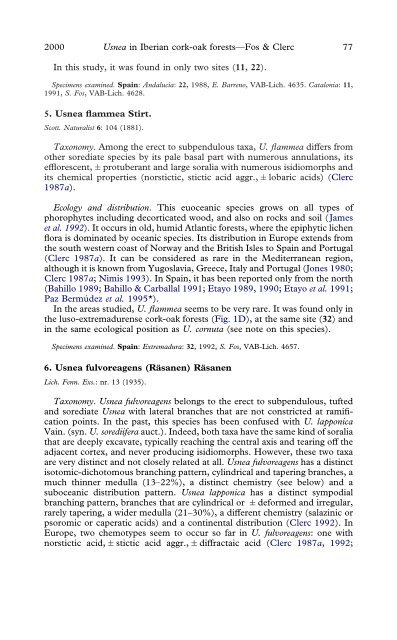the lichen genus usnea on quercus suber in iberian cork-oak forests
the lichen genus usnea on quercus suber in iberian cork-oak forests
the lichen genus usnea on quercus suber in iberian cork-oak forests
Create successful ePaper yourself
Turn your PDF publications into a flip-book with our unique Google optimized e-Paper software.
2000 Usnea <strong>in</strong> Iberian <strong>cork</strong>-<strong>oak</strong> <strong>forests</strong>—Fos & Clerc 77<br />
In this study, it was found <strong>in</strong> <strong>on</strong>ly two sites (11, 22).<br />
Specimens exam<strong>in</strong>ed. Spa<strong>in</strong>: Andalucía: 22, 1988, E. Barreno, VAB-Lich. 4635. Catal<strong>on</strong>ia: 11,<br />
1991, S. Fos, VAB-Lich. 4628.<br />
5. Usnea flammea Stirt.<br />
Scott. Naturalist 6: 104 (1881).<br />
Tax<strong>on</strong>omy. Am<strong>on</strong>g <str<strong>on</strong>g>the</str<strong>on</strong>g> erect to subpendulous taxa, U. flammea differs from<br />
o<str<strong>on</strong>g>the</str<strong>on</strong>g>r sorediate species by its pale basal part with numerous annulati<strong>on</strong>s, its<br />
efflorescent,protuberant and large soralia with numerous isidiomorphs and<br />
its chemical properties (norstictic, stictic acid aggr.,lobaric acids) (Clerc<br />
1987a).<br />
Ecology and distributi<strong>on</strong>. This euoceanic species grows <strong>on</strong> all types of<br />
phorophytes <strong>in</strong>clud<strong>in</strong>g decorticated wood, and also <strong>on</strong> rocks and soil (James<br />
et al. 1992). It occurs <strong>in</strong> old, humid Atlantic <strong>forests</strong>, where <str<strong>on</strong>g>the</str<strong>on</strong>g> epiphytic <str<strong>on</strong>g>lichen</str<strong>on</strong>g><br />
flora is dom<strong>in</strong>ated by oceanic species. Its distributi<strong>on</strong> <strong>in</strong> Europe extends from<br />
<str<strong>on</strong>g>the</str<strong>on</strong>g> south western coast of Norway and <str<strong>on</strong>g>the</str<strong>on</strong>g> British Isles to Spa<strong>in</strong> and Portugal<br />
(Clerc 1987a). It can be c<strong>on</strong>sidered as rare <strong>in</strong> <str<strong>on</strong>g>the</str<strong>on</strong>g> Mediterranean regi<strong>on</strong>,<br />
although it is known from Yugoslavia, Greece, Italy and Portugal (J<strong>on</strong>es 1980;<br />
Clerc 1987a; Nimis 1993). In Spa<strong>in</strong>, it has been reported <strong>on</strong>ly from <str<strong>on</strong>g>the</str<strong>on</strong>g> north<br />
(Bahillo 1989; Bahillo & Carballal 1991; Etayo 1989, 1990; Etayo et al. 1991;<br />
Paz Bermúdez et al. 1995*).<br />
In <str<strong>on</strong>g>the</str<strong>on</strong>g> areas studied, U. flammea seems to be very rare. It was found <strong>on</strong>ly <strong>in</strong><br />
<str<strong>on</strong>g>the</str<strong>on</strong>g> luso-extremadurense <strong>cork</strong>-<strong>oak</strong> <strong>forests</strong> (Fig. 1D), at <str<strong>on</strong>g>the</str<strong>on</strong>g> same site (32) and<br />
<strong>in</strong> <str<strong>on</strong>g>the</str<strong>on</strong>g> same ecological positi<strong>on</strong> as U. cornuta (see note <strong>on</strong> this species).<br />
Specimens exam<strong>in</strong>ed. Spa<strong>in</strong>: Extremadura: 32, 1992, S. Fos, VAB-Lich. 4657.<br />
6. Usnea fulvoreagens (Räsanen) Räsanen<br />
Lich. Fenn. Exs.: nr. 13 (1935).<br />
Tax<strong>on</strong>omy. Usnea fulvoreagens bel<strong>on</strong>gs to <str<strong>on</strong>g>the</str<strong>on</strong>g> erect to subpendulous, tufted<br />
and sorediate Usnea with lateral branches that are not c<strong>on</strong>stricted at ramificati<strong>on</strong><br />
po<strong>in</strong>ts. In <str<strong>on</strong>g>the</str<strong>on</strong>g> past, this species has been c<strong>on</strong>fused with U. lapp<strong>on</strong>ica<br />
Va<strong>in</strong>. (syn. U. sorediifera auct.). Indeed, both taxa have <str<strong>on</strong>g>the</str<strong>on</strong>g> same k<strong>in</strong>d of soralia<br />
that are deeply excavate, typically reach<strong>in</strong>g <str<strong>on</strong>g>the</str<strong>on</strong>g> central axis and tear<strong>in</strong>g off <str<strong>on</strong>g>the</str<strong>on</strong>g><br />
adjacent cortex, and never produc<strong>in</strong>g isidiomorphs. However, <str<strong>on</strong>g>the</str<strong>on</strong>g>se two taxa<br />
are very dist<strong>in</strong>ct and not closely related at all. Usnea fulvoreagens has a dist<strong>in</strong>ct<br />
isotomic-dichotomous branch<strong>in</strong>g pattern, cyl<strong>in</strong>drical and taper<strong>in</strong>g branches, a<br />
much th<strong>in</strong>ner medulla (13–22%), a dist<strong>in</strong>ct chemistry (see below) and a<br />
suboceanic distributi<strong>on</strong> pattern. Usnea lapp<strong>on</strong>ica has a dist<strong>in</strong>ct sympodial<br />
branch<strong>in</strong>g pattern, branches that are cyl<strong>in</strong>drical or deformed and irregular,<br />
rarely taper<strong>in</strong>g, a wider medulla (21–30%), a different chemistry (salaz<strong>in</strong>ic or<br />
psoromic or caperatic acids) and a c<strong>on</strong>t<strong>in</strong>ental distributi<strong>on</strong> (Clerc 1992). In<br />
Europe, two chemotypes seem to occur so far <strong>in</strong> U. fulvoreagens: <strong>on</strong>e with<br />
norstictic acid,stictic acid aggr.,diffractaic acid (Clerc 1987a, 1992;

















